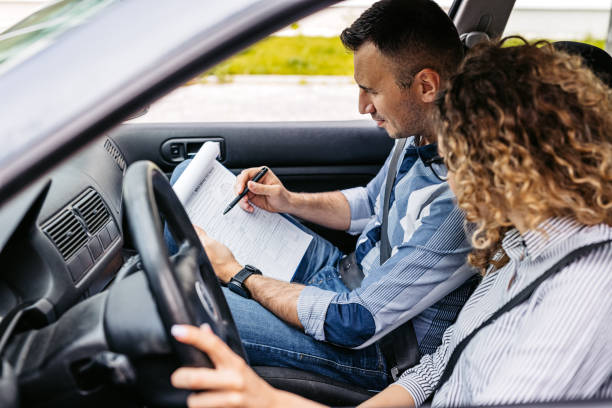May 7
/
Amir Iqbal
Everything You Need to Know Before Taking Your CDL Test
Everything You Need to Know Before Taking Your CDL Test
Embarking on a career in commercial driving is an exciting venture. For first-time drivers, obtaining a Commercial Driver's License (CDL) is the crucial first step. The process can seem daunting, but with the right preparation and resources, you can navigate it successfully. This guide provides a detailed roadmap to help you prepare for your CDL test effectively.
Understanding the CDL and Its Importance

A Commercial Driver's License (CDL) is a specialized license required to operate large or heavy vehicles, such as trucks and buses. The Federal Motor Carrier Safety Administration (FMCSA) mandates that drivers must obtain a CDL to ensure they possess the necessary skills and knowledge to operate commercial vehicles safely.
There are three classes of CDL:
Class A: Allows operation of vehicles with a combined weight of 26,001 pounds or more, provided the towed vehicle is over 10,000 pounds.
Class B: Permits operation of a single vehicle weighing 26,001 pounds or more, or towing a vehicle not exceeding 10,000 pounds.
Class C: Covers vehicles designed to transport 16 or more passengers or hazardous materials.
Understanding the class of CDL you need is essential, as it determines the type of vehicles you can operate and the endorsements required.
Steps to Obtain Your CDL

1. Meet the Basic Requirements
2. Study the CDL Manual
You can obtain the manual from your state's Department of Motor Vehicles (DMV) website or local DMV office.
Before starting the CDL process, ensure you meet the following criteria:
- Age: You must be at least 18 years old for intrastate driving and 21 for interstate driving.
- Medical Certification: Obtain a Medical Examiner's Certificate by passing a Department of Transportation (DOT) physical examination.
- Residency: Provide proof of residency in the state where you're applying.
- Identification: Present valid identification documents, such as a Social Security card and a non-commercial driver's license.
2. Study the CDL Manual
Each state provides a CDL manual that outlines the rules, regulations, and procedures for commercial driving. This manual is your primary study resource. It covers topics such as:
- Vehicle inspection procedures
- Basic control of your vehicle
- Shifting gears
- Managing speed and space
- Handling hazardous conditions
- Air brake systems
You can obtain the manual from your state's Department of Motor Vehicles (DMV) website or local DMV office.
3. Take Practice Tests
Practice tests are invaluable for assessing your knowledge and identifying areas that need improvement. They simulate the format and content of the actual CDL test, helping you become familiar with the types of questions you'll encounter.
Online platforms offer free CDL practice tests covering various sections, including:
- General Knowledge
- Air Brakes
- Combination Vehicles
- Hazardous Materials
- Passenger Transport
- Tank Vehicles
Consistent practice enhances your confidence and readiness for the actual exam.
4. Enroll in a CDL Training Program
While self-study is beneficial, enrolling in a CDL training program provides structured learning and hands-on experience. These programs offer:
- Classroom instruction on traffic laws and safety regulations
- Behind-the-wheel training with experienced instructors
- Preparation for the CDL skills test
- Assistance with job placement upon completion
Selecting a reputable training school can significantly impact your success in obtaining a CDL.
5. Obtain a Commercial Learner's Permit (CLP)
Before taking the CDL skills test, you must acquire a Commercial Learner's Permit (CLP). To obtain a CLP:
- Pass the written knowledge tests for the CDL class and any endorsements you seek.
- Submit the required identification and medical certification.
- Pay the applicable fees.
The CLP allows you to practice driving a commercial vehicle under the supervision of a licensed CDL holder.
6. Complete Entry-Level Driver Training (ELDT)
As of February 7, 2022, the FMCSA requires new drivers to complete Entry-Level Driver Training (ELDT) before taking the CDL skills test. ELDT includes:
- Theory instruction covering safety, vehicle operation, and non-driving activities.
- Behind-the-wheel training on a range and public roads.
Ensure your training provider is registered with the FMCSA's Training Provider Registry.
7. Schedule and Pass the CDL Skills Test
After meeting the training requirements and holding your CLP for the mandated period (usually 14 days), you can schedule the CDL skills test. The test comprises three parts:
- Pre-trip Inspection: Demonstrate your ability to inspect your vehicle and identify potential issues.
- Basic Vehicle Control: Show proficiency in maneuvering the vehicle in various situations, such as backing up and turning.
- On-Road Driving: Exhibit safe driving practices in real traffic conditions.
Passing the skills test earns you a CDL, allowing you to operate commercial vehicles legally.
Tips for Effective CDL Test Preparation

- Create a Study Schedule: Allocate specific times each day for studying to ensure consistent progress.
- Use Multiple Resources: Combine the CDL manual with online practice tests, flashcards, and study guides for comprehensive preparation.
- Join Study Groups: Collaborating with peers can provide different perspectives and enhance understanding.
- Stay Healthy: Adequate rest, nutrition, and exercise contribute to better focus and retention.
- Seek Feedback: Regularly assess your knowledge through quizzes and seek feedback from instructors or experienced drivers.
Common Mistakes to Avoid
- Procrastination: Delaying study sessions can lead to inadequate preparation.
- Neglecting the Manual: Relying solely on practice tests without studying the manual may leave knowledge gaps.
- Overconfidence: Underestimating the test's difficulty can result in failure.
- Ignoring Endorsements: Failing to study for necessary endorsements can limit your driving opportunities.
Conclusion
Preparing for the CDL test as a first-time driver requires dedication, structured study, and practical experience. By understanding the requirements, utilizing available resources, and committing to thorough preparation, you can achieve your goal of becoming a licensed commercial driver. Remember, the journey doesn't end with obtaining your CDL; continuous learning and adherence to safety standards are vital for a successful driving career.
For more information and resources on CDL preparation, visit Online Traffic Safety.
Who we are
Online Traffic Safety is at the forefront of delivering up-to-date and effective traffic safety training. We believe that informed drivers are safe drivers, and our goal is to equip every individual with the knowledge and skills needed to navigate the roads confidently and safely.
Featured links
Get in touch
-
info@onlinetrafficsafety.com
Connect with us
-
Facebook
-
Twitter
-
Youtube
-
Instagram
-
Linkedin
-
TikTok
Online Traffic Safety © 2025
